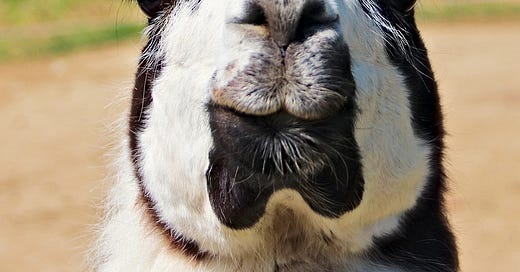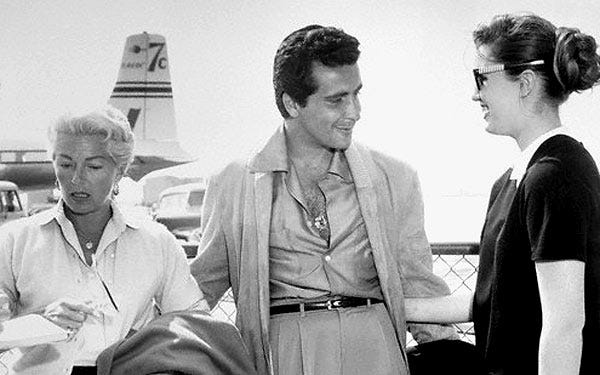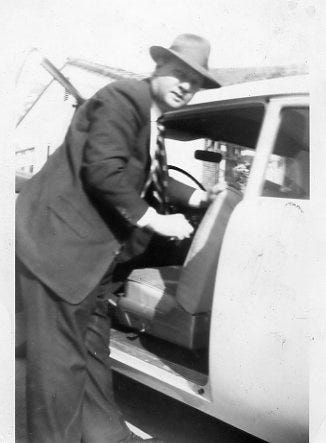Kisses, Marriage, and the Death of Johnny Stompanato
Somehow this all flows from herbivorous animals with slender necks
Random noun: Llama
Your llama (or my llama, for that matter, should either of us procure one) is native to the South American Andes, used as a pack animal or a meal (or sometimes both, as in “pack a lunch”). It has cousins in the camel and the alpaca.
Camels are noted for their humps and their cigarette factories.
Alpacas look like smaller llamas and were once prized for their wool. In America in the 1980s there was an alpaca craze for a while, people raising them in their yards hoping to sell them for a “pretty penny” (I’ve never thought Abe Lincoln was particularly pretty, even on a penny). Folks invested their life savings into alpacas, only to see the bubble burst, leaving them with a herd of manure-making fuzzies wandering around their property looking for new places to poop.
Llamas, on the other hand, continue to have worth, especially in higher altitudes where their robust red blood cells provide more oxygen than other animals.
And, apparently, llamas can be trained to "kiss" humans by puckering their lips when presented with a treat. The only downside is that while puckering they may spit in your face. Is that a risk worth taking just to get kissed by a llama?
How about a kiss from Fernando Lamas? Many women in the 1950s wanted one of those, as this Argentinean actor became a popular “Latin lover” on the silver screen. “Latin lover” does not refer to someone who is gaga about an ancient Roman language and can happily translate Illegitimi non carborundum (Don’t let the bast***s grind you down). Rather, it refers to a handsome guy with a Mexican or Spanish accent who is catnip to a certain type of American woman, i.e., rich but unhappily married. (Some wag in the 1920s came up with: “If marriage is an institution, and love is blind, is marriage an institution for the blind?”)
Fernando Lamas was married—four times—and gave a lot of kisses to his wives, which included screen beauties Esther Williams and Arlene Dahl.
Arelne Dahl was married and divorced five times, one of those being to Tarzan actor Lex Barker, who himself was divorced four times, once from Lana Turner, who tied and untied the knot seven times. This did not include the man she lived with for a time, one Johnny “Johnny Stomp” Stompanato, a bodyguard for L.A. mobster Mickey Cohen, who was married only once, though he liked the company of women who shimmied and stripped in downtown burlesque theaters, three of whom performed under the names Candy Barr, Beverly Hills, and Tempest Storm (I’m not kidding).
Johnny Stomp liked to strut around as a tough guy.
And then he met Sean Connery. This was 1958, and Connery was starring in a movie with Lana Turner called Another Time, Another Place. The Stomp heard rumors that the two were keeping company off the set. In a rage he called Turner in London, where the picture was being shot, and threatened to kill or disfigure her. Johnny was quite the charmer.
Lana hung up on him, so Johnny hopped a plane to London and forced his way onto the set. Connery and Turner were rehearsing a scene, embracing on a couch. Stompanato went right up to Connery, pointed a pistol at his head, and told him to take his hands off Lana.
He picked the wrong star to mess with.
Connery, at a chiseled 6’2”, was no powder puff. He’d served in the Royal Navy, and later was offered a professional football (soccer) contract.
Sean grabbed Johnny’s wrist, twisted the gun out of his hand, and decked him with one punch. Scotland Yard came and took Stompanato in. He was deported for breaking England’s gun laws.
The thug might have exacted revenge, were it not for an intervening event, namely his death.
Lana Turner had a daughter named Cheryl Crane. One night in Lana’s Beverly Hills home, Johnny Stomp was being his usual abusive self. Cheryl, age 14, fearing Stompanato might kill her mother, grabbed a butcher knife and ran into the bedroom and plunged it into Johnny’s stomach. “What are you doing?” he cried out (not the sharpest knife in the drawer, Johnny Stomp, if I may use that analogy). He didn’t make it. There was a coroner's inquest, and the press was naturally all over it, especially when Lana Turner herself took the stand. The verdict was justifiable homicide, and Cheryl Crane was not charged.
The lawyer for Cheryl Crane was one Jerry Giesler, the same lawyer who represented Robert Mitchum when he was busted for smoking Mary Jane in 1948. Giesler was the go-to lawyer for Hollywood bigwigs in trouble, including Charlie Chaplin and Errol Flynn.
My dad ran across both Mickey Cohen and Jerry Giesler at one time or another, since you couldn’t practice criminal law in L.A. back then and not walk by both these men in the downtown courthouse. I remember my dad talking about Mickey Cohen. While New York had its mafia families, and Chicago its crime syndicates, Los Angeles had Mickey, and the LAPD couldn’t nail him. It took a federal tax rap to stop Mickey, the way the feds had stopped Al Capone way back when.
Dad started practicing law in the early 1950s. Those years were lived in black-and-white (at least in my imagination) because TV shows like Dragnet and Perry Mason were always in black and white. We didn’t get a color TV until around 1964, and those you had to constantly adjust or Walter Cronkite’s skin would be green.
Color TV was also the best way to see The Wizard of Oz, and when it was shown back then the broadcast was hosted by Danny Kaye, who would issue a reminder that the movie starts out in black and white. “So if you have a color TV there’s nothing wrong with your set.” That meant there were still millions watching the movie in black and white, which sort of defeats the wonder of Oz and munchkins and the Emerald City.
The 1950s was also the era of the LAPD’s secret “hat squad,” four tough cops in suits and fedoras who were tasked with keeping organized crime out of Los Angeles. They would get word that a criminal bigwig was coming to town, meet him at the airport, and take him “for a ride” into the hills above Hollywood, beat the ever-loving malfeasance out of him, then put him on a plane back home. They made a movie about these guys called Mulholland Falls, starring Nick Nolte. There’s a scene where they take a hood up to Mulholland Drive, bloody him, and are about to toss him into a canyon. The gangster says, “You can’t do that, this is America.”
To which Nolte replies, “This isn’t America, Jack. This is L.A.”
Quotes:
“Tip the world over on its side and everything loose will land in Los Angeles.” – Frank Lloyd Wright
“When its 100 degrees in New York, it's 72 in Los Angeles. When its 30 degrees in New York, in Los Angeles it's still 72. However, there are 6 million interesting people in New York, and only 72 in Los Angeles.” – Neil Simon
“Fall is my favorite season in Los Angeles, watching the birds change color and fall from the trees.” – David Letterman







This post about llamas that are herbivores and romantic relationships reminds me of something in Japanese pop culture. You may have noticed I like to write about Japan. Single, heterosexual men in Japan are sometimes classified as carnivores and herbivores. A carnivore is a man who is assertive about pursuing women in romantic or sexual relationships; in other words, a guy who doesn’t shy away from “hitting on” on women for dates and flirting. A herbivore is someone who isn’t assertive about relationships with women. Perhaps they’re shy or not confident about asking a woman out for a date. Some are absorbed in self-indulgent hobbies and interests like comic books and fantasy figurines. They are sometimes known as otaku (translated as geek or nerd). In Japanese TV dramas you see both carnivorous and herbivorous male characters. In general, women view herbivores in a negative light; nice to be friends with, but dating—forget it.
If I had to choose, Jim, I'd take alpacas over llamas. There's some folks who live down the road from us who have a herd of alpacas, and they're darn cute!